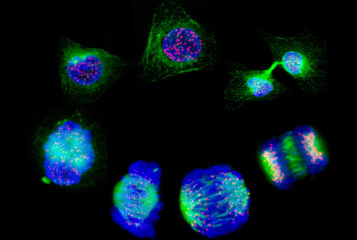US scientists have developed a method of making precise edits to mitochondrial DNA within living cells.
Researchers from the Broad Institute of MIT and Harvard in Massachusetts and the University of Washington School of Medicine developed a new approach that combines features of CRISPR-based base editing with an older approach known as TALENs, to correct point mutations in the mitochondrial genome.
'It's a quantum leap forward' said the Broad Institute's Professor Vamsi Mootha, one of the authors of the study, which is published in Nature. 'This is the first time in my career that we've been able to engineer a precise edit in mitochondrial DNA.'
Mitochondria are self-contained organelles found in almost every cell in the human body, where they generate the energy to power the cell. Mitochondria contain their own genomes – circular pieces of DNA completely separate from chromosomes in the cell's nucleus.
While the mitochondrial genome was the first part of human DNA to be sequenced, it has become one of the last to be usefully edited.
CRISPR/Cas9 genome editing – which has been phenomenally successful in nuclear DNA does not work in mitochondria because the guide RNA molecules cannot cross the membrane that surrounds each mitochondrion. Additionally, the DNA repair mechanisms that mend the double-stranded breaks caused by Cas9 are not present in mitochondria.
Previous methods of genome editing, such as zinc-finger nucleases and TALENs were able to cut mitochondrial DNA but would destroy it in the process, rendering targeted changes impossible.
The new approach harnesses a toxin found in bacteria to change a cytosine base in the DNA code to a thiamine, and so has the potential to correct some point mutations in the mitochondrial genome. The discovery of this toxin by researchers at the University of Washington led Professor Joseph Mougous to contact Professor David Liu at the Broad Institute, who is known for developing base editing (see BioNews 848).
Together, the labs worked to deliver the editor in a way that negated its toxicity and paired it with a TALE (transcription activator-like effector) – a protein guide like those used in TALENs which, unlike CRISPR RNA can cross the mitochondrial membrane.
'A mitochondrial genome editor has the long-term potential to be developed into a therapeutic to treat mitochondrial-derived diseases, and it has more immediate value as a tool that scientists can use to better model mitochondrial diseases and explore fundamental questions pertaining to mitochondrial biology and genetics,' Professor Mougous said.
Sources and References
-
Mitochondrial genome editing gets precise
-
Scientists make precise gene edits to mitochondrial DNA for first time
-
A bacterial cytidine deaminase toxin enables CRISPR-free mitochondrial base editing
-
The powerhouses inside cells have been gene-edited for the first time
-
Gene-editing discovery could point the way toward a 'holy grail': cures for mitochondrial diseases
-
New method to edit cell's 'powerhouse' DNA could help study variety of genetic diseases
-
New type of base editor works on mitochondrial DNA
-
How to Precisely Edit Mitochondrial DNA
-
New molecular tool precisely edits mitochondrial DNA





Leave a Reply
You must be logged in to post a comment.